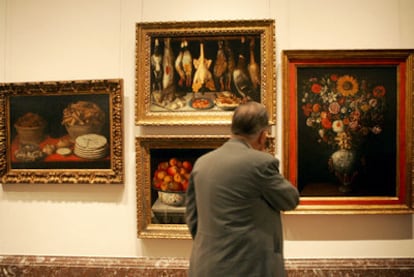Picture puzzle: which former PP treasurer bought the Gürtel paintings?
Ex-party finance chief Luis Bárcenas did not buy still-lifes, says deal mediator
One of the charges of the Gürtel case - the wide-ranging bribes-for-contracts scandal affecting the opposition Popular Party (PP) - orbiting around Luis Bárcenas, the party's former national treasurer, concerns the suspicious sale of two paintings in 2002. Bárcenas allegedly took out a 325,000-euro bank loan to make the purchase, which he paid back six weeks later plus 5,000 euros interest.
Police, who never managed to verify the deal, suspect it was a maneuver to launder money. Bárcenas pleaded in court that he never carried out the transaction and so never profited from it.
Now, an art expert who acted as an intermediary in the sale has confirmed Bárcenas' version of the story to EL PAÍS. Miguel Granados says the purchase was the work of another former PP treasurer, Rosendo Naseiro. Naseiro was treasurer when, just after José María Aznar became party leader in 1989, an illegal financing scandal erupted for which he was investigated.
The Supreme Court shelved the case despite wire-tap recordings - authorized because of a different issue - that proved the corruption of PP managers. Since then, Naseiro has been assembling a multi-million-euro art collection and, over time, struck up a friendship with Bárcenas.
According to Granados, the owner of the two still-lifes by the painter Juan Van der Hamen, Luis Ortiz, offered them to him in 2002, but the art expert considered them beyond his price range and instead put the seller in touch with Naseiro, who he knew to be a fan of the artist.
"I only know that he bought them and he told me he showed them to Bárcenas," says Granados. "This is the truth and it is what I have already told the police who came to question me about this transaction and what I declared in a notarial deed."
The transparency of Granados, son of a former Socialist state prosecutor, is in stark contrast to the opacity of the deal's other participants. When confronted with Granados' accusation that he, rather than Bárcenas, was responsible for the sale of the paintings, Naseiro said he had "nothing to say," while Luis Ortiz did not respond to EL PAÍS' calls. Bárcenas and the manager of the bank which gave him the loan also declined to give their versions.
Known sources from the transaction say Bárcenas went with Naseiro to see the manager to apply for the loan. So why did Bárcenas ask for the money? According to people linked to the deal, he took it out to lend to Naseiro to buy the still-lifes, but in the end Naseiro told him the transaction wouldn't be made and his money wouldn't be necessary. Naseiro compensated him the extra 5,000 euros, writing it off as expenses, and Bárcenas gave the whole amount back, paying it as he received it: in 500-euro notes.

The PP's ex-money man
Luis Bárcenas is one of the main figures under investigation into the Gürtel bribes-for-public contracts scandal that has engulfed the opposition Popular Party (PP). According to investigators, the former PP treasurer received around 1.3 million euros from the Gürtel ring.
Bárcenas, who resigned his post and Senate seat in April 2010 over the scandal, controlled the finances of the PP for over 20 years, first as a manager then, more recently, as party treasurer.
Eager to get the case shelved, he has so far only given evidence to the Supreme Court once, in July 2009, to justify a cash deposit of 330,000 euros in his account related to the paying back of a bank loan. The judge was unconvinced by his explanation and maintained the charges.
Tu suscripción se está usando en otro dispositivo
¿Quieres añadir otro usuario a tu suscripción?
Si continúas leyendo en este dispositivo, no se podrá leer en el otro.
FlechaTu suscripción se está usando en otro dispositivo y solo puedes acceder a EL PAÍS desde un dispositivo a la vez.
Si quieres compartir tu cuenta, cambia tu suscripción a la modalidad Premium, así podrás añadir otro usuario. Cada uno accederá con su propia cuenta de email, lo que os permitirá personalizar vuestra experiencia en EL PAÍS.
¿Tienes una suscripción de empresa? Accede aquí para contratar más cuentas.
En el caso de no saber quién está usando tu cuenta, te recomendamos cambiar tu contraseña aquí.
Si decides continuar compartiendo tu cuenta, este mensaje se mostrará en tu dispositivo y en el de la otra persona que está usando tu cuenta de forma indefinida, afectando a tu experiencia de lectura. Puedes consultar aquí los términos y condiciones de la suscripción digital.
Últimas noticias
Half of Scotland is in the hands of 420 property owners
From digital curfews to blocking apps: How technology experts protect their children online
Why the price of coffee has skyrocketed: from Brazilian plantations to specialty coffee houses
Confined to a Cuban hospital: When electricity is a matter of life or death
Most viewed
- Pablo Escobar’s hippos: A serious environmental problem, 40 years on
- Why we lost the habit of sleeping in two segments and how that changed our sense of time
- Trump’s obsession with putting his name on everything is unprecedented in the United States
- Charles Dubouloz, mountaineering star, retires at 36 with a farewell tour inspired by Walter Bonatti
- The Florida Keys tourist paradise is besieged by immigration agents: ‘We’ve never seen anything like this’








































